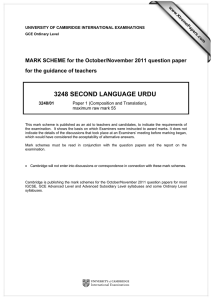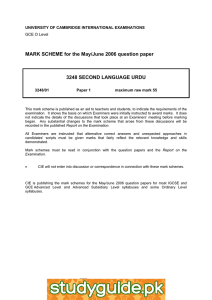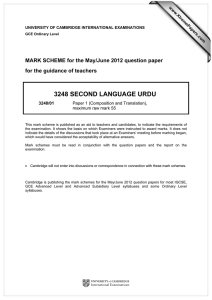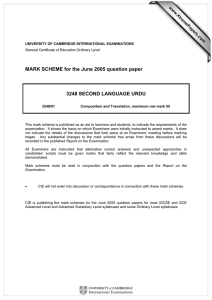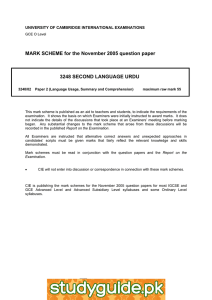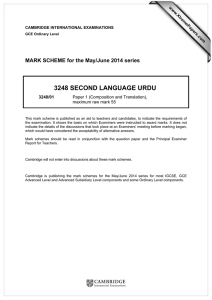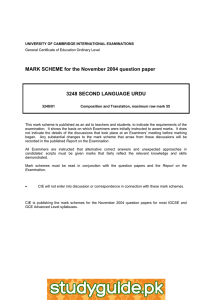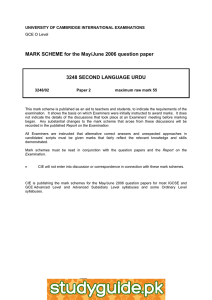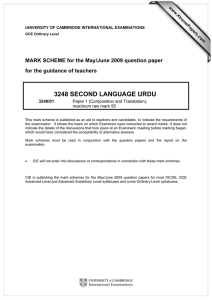3248 SECOND LANGUAGE URDU for the guidance of teachers
advertisement
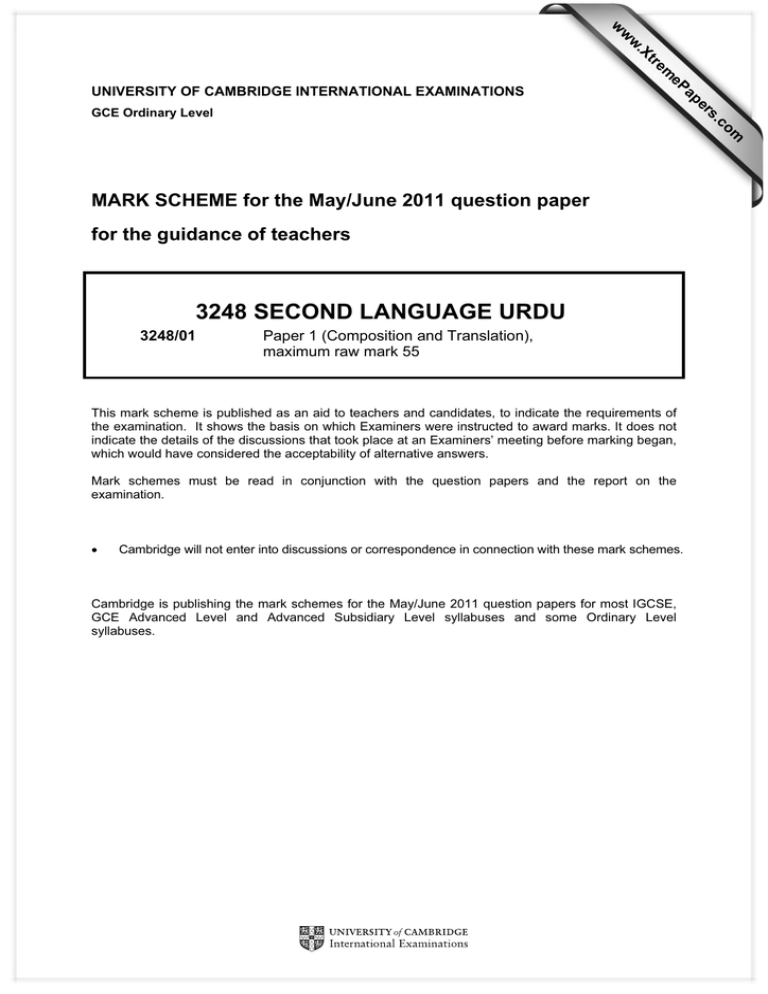
w w ap eP m e tr .X w UNIVERSITY OF CAMBRIDGE INTERNATIONAL EXAMINATIONS s er om .c GCE Ordinary Level MARK SCHEME for the May/June 2011 question paper for the guidance of teachers 3248 SECOND LANGUAGE URDU 3248/01 Paper 1 (Composition and Translation), maximum raw mark 55 This mark scheme is published as an aid to teachers and candidates, to indicate the requirements of the examination. It shows the basis on which Examiners were instructed to award marks. It does not indicate the details of the discussions that took place at an Examiners’ meeting before marking began, which would have considered the acceptability of alternative answers. Mark schemes must be read in conjunction with the question papers and the report on the examination. • Cambridge will not enter into discussions or correspondence in connection with these mark schemes. Cambridge is publishing the mark schemes for the May/June 2011 question papers for most IGCSE, GCE Advanced Level and Advanced Subsidiary Level syllabuses and some Ordinary Level syllabuses. Page 2 Mark Scheme: Teachers’ version GCE O LEVEL – May/June 2011 Syllabus 3248 Paper 01 Part 1: Directed Writing (15 marks) The syllabus specifies that the candidates are to write an essay in Urdu of about 150 words. Examiners are to read up to 200 words and ignore any further writing. If one bullet point is not covered at all, then the maximum mark for language is 7. Language (out of 9) Content (out of 6) 8–9 Very good Confident use of complex sentence patterns, generally accurate, extensive vocabulary, good sense of idiom. 5–6 Very good Detailed, clearly relevant and well illustrated; coherently argued and structured. 6–7 Good Generally sound grasp of grammar in spite of quite a few lapses; reads reasonably; some attempt at varied vocabulary and sentence patterns. 4 Good Sound knowledge and generally relevant; some ability to develop argument and draw conclusions. 4–5 Adequate A tendency to be simple, clumsy or laboured; some degree of accuracy; inappropriate use of idiom. 3 Adequate Some knowledge, but not always relevant; a more limited capacity to argue. 2–3 Poor Consistently simple or pedestrian sentence patterns (basic sentence structure) with persistent errors; limited vocabulary. 2 Poor Some attempt at argument, tends to be sketchy or unspecific; little attempt to structure an argument; major misunderstanding of question. 0–1 Very poor 0–1 Very poor Vague and general, ideas presented at random. Only the simplest sentence patterns, little evidence of grammatical awareness, very limited vocabulary. © University of Cambridge International Examinations 2011 Page 3 Mark Scheme: Teachers’ version GCE O LEVEL – May/June 2011 Syllabus 3248 Paper 01 Part 2: Letter, Report, Dialogue or Speech (20 marks) The syllabus specifies that the candidates are to write in Urdu of about 200 words. Language (out of 15) Content (out of 5) 13–15 Very good Confident use of complex sentence patterns, generally accurate, extensive vocabulary, good sense of idiom. 5 Very good Detailed, clearly relevant and well illustrated; coherently argued and structured. 10–12 Good Generally sound grasp of grammar in spite of quite a few lapses; reads reasonably; some attempt at varied vocabulary and sentence patterns. 4 Good Sound knowledge and generally relevant; some ability to develop argument and draw conclusions. 7–9 Adequate A tendency to be simple, clumsy or laboured; some degree of accuracy; inappropriate use of idiom. 3 Adequate Some knowledge, but not always relevant; a more limited capacity to argue. 4–6 Poor Consistently simple or pedestrian sentence patterns (basic sentence structure) with persistent errors; limited vocabulary. 2 Poor Some attempt at argument, tends to be sketchy or unspecific; little attempt to structure an argument; major misunderstanding of question. 0–1 Very poor 0–3 Very poor Vague and general, ideas presented at random. Only the simplest sentence patterns, little evidence of grammatical awareness, very limited vocabulary. © University of Cambridge International Examinations 2011 Page 4 Mark Scheme: Teachers’ version GCE O LEVEL – May/June 2011 Syllabus 3248 Part 3: Translation (20 marks) English 1 Along with many other nations 2 Pakistan's fishing industry 3 is facing 4 numerous problems. 5 Sea levels are rising 6 so salt water is flowing 7 further into rivers 8 and is affecting 9 fresh water fish. Urdu accept 10 Ocean fish stocks 11 are also declining 12 because of over-fishing 13 and pollution. 14 Fishing with nets 15 is the most common method in Pakistan. 16 Repairing them is mostly done by hand 17 as little modern machinery 18 is available. 19 Boats are usually brightly painted 20 and vary from © University of Cambridge International Examinations 2011 Paper 01 Page 5 Mark Scheme: Teachers’ version GCE O LEVEL – May/June 2011 Syllabus 3248 Paper 01 21 large motor boats 22 to small rowing boats. 23 Some fishermen 24 have had to become expert mechanics 25 because they have to rely on their engines 26 while far out at sea. 27 Nowadays many fisherman 28 are deciding to become full time motor mechanics 29 because it is a more reliable 30 source of income 31 than relying on 32 an uncertain future at sea. 33 The average catch 34 is now less than two tonnes a day 35 whereas only twenty years ago 36 it was as much as six or seven tonnes a day. 37 About twenty five percent of this catch 38 is exported 39 mainly to Europe 40 bringing in over 200 million dollars annually. As in any language translation there are different ways of translating to and from any language. This example here gives a good sense of the original English. Examiners will need to read candidates’ work and judge how well the candidate had transferred the meaning of the original. Mark each phrase out of 1 putting mark in the margin. Add up the marks (out of 40) then divide by 2 to get a final mark out of 20. NB This is not marked for written accuracy but for meaning. © University of Cambridge International Examinations 2011
